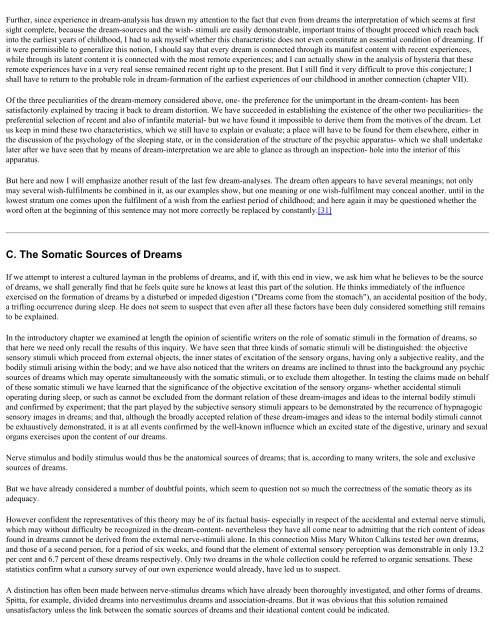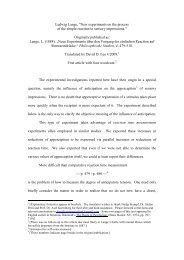The Interpretation Of Dreams Sigmund Freud (1900) PREFACE
The Interpretation Of Dreams Sigmund Freud (1900) PREFACE
The Interpretation Of Dreams Sigmund Freud (1900) PREFACE
Create successful ePaper yourself
Turn your PDF publications into a flip-book with our unique Google optimized e-Paper software.
Further, since experience in dream-analysis has drawn my attention to the fact that even from dreams the interpretation of which seems at first<br />
sight complete, because the dream-sources and the wish- stimuli are easily demonstrable, important trains of thought proceed which reach back<br />
into the earliest years of childhood, I had to ask myself whether this characteristic does not even constitute an essential condition of dreaming. If<br />
it were permissible to generalize this notion, I should say that every dream is connected through its manifest content with recent experiences,<br />
while through its latent content it is connected with the most remote experiences; and I can actually show in the analysis of hysteria that these<br />
remote experiences have in a very real sense remained recent right up to the present. But I still find it very difficult to prove this conjecture; I<br />
shall have to return to the probable role in dream-formation of the earliest experiences of our childhood in another connection (chapter VII).<br />
<strong>Of</strong> the three peculiarities of the dream-memory considered above, one- the preference for the unimportant in the dream-content- has been<br />
satisfactorily explained by tracing it back to dream distortion. We have succeeded in establishing the existence of the other two peculiarities- the<br />
preferential selection of recent and also of infantile material- but we have found it impossible to derive them from the motives of the dream. Let<br />
us keep in mind these two characteristics, which we still have to explain or evaluate; a place will have to be found for them elsewhere, either in<br />
the discussion of the psychology of the sleeping state, or in the consideration of the structure of the psychic apparatus- which we shall undertake<br />
later after we have seen that by means of dream-interpretation we are able to glance as through an inspection- hole into the interior of this<br />
apparatus.<br />
But here and now I will emphasize another result of the last few dream-analyses. <strong>The</strong> dream often appears to have several meanings; not only<br />
may several wish-fulfilments be combined in it, as our examples show, but one meaning or one wish-fulfilment may conceal another. until in the<br />
lowest stratum one comes upon the fulfilment of a wish from the earliest period of childhood; and here again it may be questioned whether the<br />
word often at the beginning of this sentence may not more correctly be replaced by constantly.[31]<br />
C. <strong>The</strong> Somatic Sources of <strong>Dreams</strong><br />
If we attempt to interest a cultured layman in the problems of dreams, and if, with this end in view, we ask him what he believes to be the source<br />
of dreams, we shall generally find that he feels quite sure he knows at least this part of the solution. He thinks immediately of the influence<br />
exercised on the formation of dreams by a disturbed or impeded digestion ("<strong>Dreams</strong> come from the stomach"), an accidental position of the body,<br />
a trifling occurrence during sleep. He does not seem to suspect that even after all these factors have been duly considered something still remains<br />
to be explained.<br />
In the introductory chapter we examined at length the opinion of scientific writers on the role of somatic stimuli in the formation of dreams, so<br />
that here we need only recall the results of this inquiry. We have seen that three kinds of somatic stimuli will be distinguished: the objective<br />
sensory stimuli which proceed from external objects, the inner states of excitation of the sensory organs, having only a subjective reality, and the<br />
bodily stimuli arising within the body; and we have also noticed that the writers on dreams are inclined to thrust into the background any psychic<br />
sources of dreams which may operate simultaneously with the somatic stimuli, or to exclude them altogether. In testing the claims made on behalf<br />
of these somatic stimuli we have learned that the significance of the objective excitation of the sensory organs- whether accidental stimuli<br />
operating during sleep, or such as cannot be excluded from the dormant relation of these dream-images and ideas to the internal bodily stimuli<br />
and confirmed by experiment; that the part played by the subjective sensory stimuli appears to be demonstrated by the recurrence of hypnagogic<br />
sensory images in dreams; and that, although the broadly accepted relation of these dream-images and ideas to the internal bodily stimuli cannot<br />
be exhaustively demonstrated, it is at all events confirmed by the well-known influence which an excited state of the digestive, urinary and sexual<br />
organs exercises upon the content of our dreams.<br />
Nerve stimulus and bodily stimulus would thus be the anatomical sources of dreams; that is, according to many writers, the sole and exclusive<br />
sources of dreams.<br />
But we have already considered a number of doubtful points, which seem to question not so much the correctness of the somatic theory as its<br />
adequacy.<br />
However confident the representatives of this theory may be of its factual basis- especially in respect of the accidental and external nerve stimuli,<br />
which may without difficulty be recognized in the dream-content- nevertheless they have all come near to admitting that the rich content of ideas<br />
found in dreams cannot be derived from the external nerve-stimuli alone. In this connection Miss Mary Whiton Calkins tested her own dreams,<br />
and those of a second person, for a period of six weeks, and found that the element of external sensory perception was demonstrable in only 13.2<br />
per cent and 6.7 percent of these dreams respectively. Only two dreams in the whole collection could be referred to organic sensations. <strong>The</strong>se<br />
statistics confirm what a cursory survey of our own experience would already, have led us to suspect.<br />
A distinction has often been made between nerve-stimulus dreams which have already been thoroughly investigated, and other forms of dreams.<br />
Spitta, for example, divided dreams into nervestimulus dreams and association-dreams. But it was obvious that this solution remained<br />
unsatisfactory unless the link between the somatic sources of dreams and their ideational content could be indicated.



